Footrot Flats: The Dog’s (Tail) Tale (1987) is regarded as a New Zealand animated feature film but it was entirely animated in Sydney, Australia by an Australian director, Robbert Smit.
Smit’s career began as a comic book artist but he moved into animation as a storyboard artist for Rocket Robin Hood. He later found a full time home at Hanna-Barbera’s Australian animation studio.
Creator Murray Ball co-directed and oversaw the entire production from New Zealand thanks to phones, faxes and frequent visits from Smit. For marketing purposes, Ball is listed as the sole director with Smit sometimes being listed as “animation director”.
Ball was intent on making the film one hundred percent Kiwi (New Zealand) even to having Australian background artist Richard Zaloudek brought to New Zealand to study rural settings, building styles and colors.
It was one of the most successful animated features in history in terms of reviews and earnings, except in the United States where it couldn’t find a distribution deal because the newspaper strip characters were totally unfamiliar to American audiences.
Ball and cartoonist Charles Schulz each admired the other’s work. One Footrot Flats strip shows Dog laughing at a Snoopy cartoon and Schulz wrote the introduction to the only Footrot Flats book collection published in the United States at the time.
Based on Ball’s very popular Australian comic strip, the film recounted the adventures of Wal Footrot, a well-intentioned slob of a New Zealand sheep rancher, and his border collie sheepdog just called “Dog” who narrates the film.
The humor in the film has often been described as very earthy and raunchy and that was also part of the appeal of the original newspaper strip that featured such graphic rural elements as birthing lambs, slaughtering livestock, studding animals and more.
While Dog’s main responsibilites were to keep things in order on the ranch, he often found time for other activities including his love affair with Jess. Wal enjoys “manly” activities like sports and his love for a local woman, Cheeky Hobson.
Ball insisted that Dog behave as a real animal and not a Disney imitation including the fact that Dog’s lips never move even when talking. In the strip, Dog’s thoughts are in thought balloons. Local star Peter Rowley was chosen for the voice of Dog and the rest of the voice cast was filled out by other well-known New Zealand comedy stars.
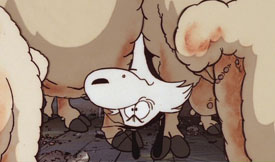 The strip inspired not only the animated feature but merchandise, book collections, a stage musical and a theme-park known as Footrot Flats Leisure Park and also Footrot Flats Fun Park in Te Atatu Peninsula, West Auckland.
The strip inspired not only the animated feature but merchandise, book collections, a stage musical and a theme-park known as Footrot Flats Leisure Park and also Footrot Flats Fun Park in Te Atatu Peninsula, West Auckland.
Music for the film was composed by Dave Dobbyn. He wrote the songs to the videotaped storyboards rather than being distracted by the final animation. Two of the songs (Slice of Heaven and Wouldn’t You Rather Be in Love) became number one singles with Slice going gold in less than five weeks and became known as the unofficial New Zealand national anthem.
A company, Magpie Productions, was set up and a temporary animation studio created expressly for the purpose of making this one film. Most of the over 150 member staff were poached from Hanna-Barbera’s Australian studio (that operated from 1972 to 1988) just as Walt Disney Animation Australia would later do in 1989.
It was six months in development and fifteen months in the making with a budget of five million dollars raised in ten days from 600 investors. Ball and his cartoonist friend Tom Scott wrote the script that before editing logged in at over 100 minutes. Final running time was closer to seventy-five minutes. Scott suggested using some jokes from published strips, but Ball was adamant the film should be all-new material.
“We knew nothing about film animation,” Scott said in 1987. “I think that has really helped in achieving our unique animation style. We didn’t set out at all to be like Disney. We wanted it to be just like opening up the comic strip — then someone taps a magic wand and the scene floods with colour and the characters start to walk and talk.”

As authors Dan and Lienors Torre of Australian Animation: An International History revealed, “Although there was a healthy pool of talented animators, a number of less experienced people were also given opportunities.
“One animator, given a substantial amount of scenes to take home, was never heard from again; no matter how they tried, they could not find him and finally resorted to hiring a private investigator to track him down and to collect the mostly unfinished work.
“Another freelancer was employed to ‘clean’ a large quantity of painted cels – to carefully remove any fingerprints, grime or dust with alcohol so that they would be ready for the camera. A few days later, the freelancer brought back the parcel of cels, was paid his fee and departed. Later, when the package was opened, it was found that the cels had indeed been cleaned; the painted drawings had been scrubbed off, leaving a stack of sparkling clean, but entirely blank cels.”
The film opened in New Zealand November 1986 to enthusiastic reviews and record box-office dollars. In its first twelve days, it earned over a million dollars at only 28 theaters. During its initial run, it earned over two and a half million dollars in that country alone.
At the time, it was the highest grossing film in New Zealand beating out films like Star Wars, Raiders of the Lost Ark and E.T.
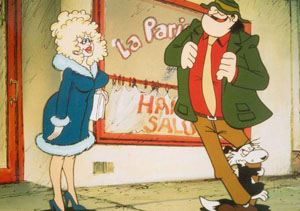 However some local reviewers felt that while Ball had all the ingredients from the strip in the film, it lacked the same flavor of the strip and was too cute.
However some local reviewers felt that while Ball had all the ingredients from the strip in the film, it lacked the same flavor of the strip and was too cute.
It later opened in the Spring of 1987 in Australia and once again received rave reviews and box office success eventually grossing over four million dollars making it the most successful animated film in Australia until Disney’s The Lion King (1994) many years later.
In the United States, there was little interest in the film with distributors feeling it was too “down under” in tone and subject matter for American audiences. In addition, the characters were unfamiliar to American audiences since the strip did not appear in the States nor was it a film geared to children like most animated features but yet it was not an “adult” animated feature like Fritz the Cat or Heavy Metal.
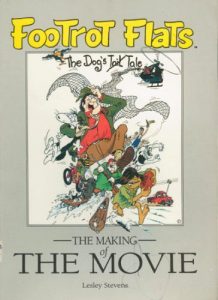 In the summer of 1987, the 2nd Los Angeles Animation Celebration showed the film and it won the prize for Best Animated Feature beating out the top contender The Brave Little Toaster.
In the summer of 1987, the 2nd Los Angeles Animation Celebration showed the film and it won the prize for Best Animated Feature beating out the top contender The Brave Little Toaster.
The film was released on VHS and later DVD/BluRay. A book featuring animation stills retelling the story of the movie Magpie Productions Presents Footrot Flats: The Dog’s Tale was released as was Footrot Flats: The Dog’s Tale, The Making of the Movie by Lesley Stevens.
Ball stopped drawing Footrot Flats in 1995. He noted that Dog would, by then, be old and his muzzle streaked with grey … and he “couldn’t let that happen to his old mate”. So, he retired the strip, reflecting that, in Footrot Flats, he was “Just happy to have struck something people like”.
My thanks to my good friend and former writing partner John Cawley who introduced me to Footrot Flats and gifted me with several copies of the Australian strip reprint books that are still in my personal library.


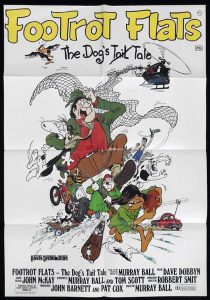
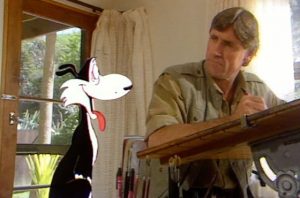
 Jim Korkis is an internationally respected animation historian who in recent years has devoted his attention to the many worlds of Disney. He was a columnist for a variety of animation magazines. With his former writing partner, John Cawley, he authored several animation related books including The Encyclopedia of Cartoon Superstars, How to Create Animation, Cartoon Confidential and Get Animated’s Animation Art Buyer’s Guide. He taught animation classes at the Disney Institute in Florida as well as instructing classes on acting and animation history for Disney Feature Animation: Florida.
Jim Korkis is an internationally respected animation historian who in recent years has devoted his attention to the many worlds of Disney. He was a columnist for a variety of animation magazines. With his former writing partner, John Cawley, he authored several animation related books including The Encyclopedia of Cartoon Superstars, How to Create Animation, Cartoon Confidential and Get Animated’s Animation Art Buyer’s Guide. He taught animation classes at the Disney Institute in Florida as well as instructing classes on acting and animation history for Disney Feature Animation: Florida.




















































A New Zealander friend sent me a few volumes of Footrot Flats in the ’80s, and I was very impressed. It was extraordinarily well-drawn and well-written, with a large and amusing cast and a central character comparable to Snoopy in wit and resourcefulness. The comic strip is still fondly remembered by many people on both sides of the Tasman after over a quarter of a century.
I was frankly disappointed with the Footrot Flats movie. I think its main problem was that not only was Murray Ball working in an unfamiliar medium, but he had never before had to create a narrative on the sort of scale that could sustain a feature. The film has excellent animation and boasts some memorable sequences, but the pacing is slow and irregular.
Anyone interested in New Zealand animation should check out “Bro’Town”, which ran on NZ TV from 2004 to 2009 for a total of maybe 30 episodes. Created by a comedy troupe called the Naked Samoans, it concerns a group of adolescent boys of Pacific Islander heritage living in the Auckland suburb of Morningside and was variously billed as “The Simpsons of the South Pacific” and “The South Park of the South Pacific”, neither of which is wholly accurate. The show was wildly popular during its run and featured cameos by many renowned New Zealanders, from Russell Crowe and Lucy Lawless to the All Blacks (the national rugby team) to Prime Minister Helen Clark and Prince Charles. It was also one of the few successful TV cartoons of the 21st century to use traditional ink-and-paint cel animation. I thought it was pretty funny and definitely worth watching, though a lot of the jokes you kind of have to be a Kiwi to understand.
I remember Murray Ball’s comic strip Stanley, which ran in Punch for many years, but I’d never heard of Footrot Flats. Thanks!
Thanks for this post! As an Australian, this is my all time favourite comic strip, and dare I say, Favourite Animated Movie. It’s a shame they never gave it a chance in U.S.A, I think after a while you guys really would have got the rhythm of the humour and enjoyed it.
It was a nice surprise to read this post, and I hope others will take the opportunity to find the movie, or get the comic books, it truly is wonderful series!
Silver Age WB fans might be interested to know that Jon McClenahan, best known for his work on Tiny Toons, Taz-Mania, Animaniacs, and Histeria! did some animation in this movie: https://www.sakugabooru.com/post/show/127289
By the way, animation director Robbert Smit spells his first name with two Bs.
Thank you – I’ve amended the text with that correction.
I was in Sydney checking out facilities for “Family Dog” and already knew some of the crew when they were finishing this feature. The Backgrounds looked totally alien to them but when I visited New Zealand next, yep, that’s what it looks like.
According to my journal the film didn’t play in New Zealand until January 1987 (their Summer vacation). I saw it twice (a week apart) on Wednesday, January 21, 1987 and Wednesday, January 28 at the Regent One in Christchurch.
The film had just opened a few days earlier and I thought I’d have my choice of seats but that theater was almost full, on a Wednesday! A week later, it was almost the same!
Kiwi’s loved this film! It was about them! It wasn’t some post apocalyptic art house movie; it was a comedy with music that took its setting for granted (and didn’t). It didn’t pander to children. It wasn’t formulaic. It was true to itself. It’s the way all films should be.
The one bizarre thing about watching this movie, at that place, at that time (and I hope there are some other witnesses who can corroborate this) was that there was almost zero audience reaction. They stifled any laughter so as to not miss a second of their film.
Jim: Animator Jon McClenahan worked on the FOOTROT FLATS before he headed here to work with Kennedy Animation in Chicago and then start up his own studio, StarToons – working on projects for Steven Spielberg and Warner Bros: TINY TOON ADVENTURES, TAZ-MANIA and ANIMANIACS. I kept in touch with Jon for a few years but then heard he moved to Europe, back to the US, etc. working on the TOM AND JERRY revival feature films for Turner Entertainment. I don’t know how to contact him right now, but he might be a good source for more material on FOOTROT FLATS. The film – at the time he mentioned it – meant nothing to me. I had never heard of the Australian newspaper comic strip or anything about it. Maybe somebody around here can contact Jon and he can tell you more about the production.
Kennedy Cartoons was in Canada, StarToons was in Chicago.
I know very well where StarToons was. It was in a far suburb of Chicago called Homewood, Illinois. It too me a bus, and two trains to get there! I got a tour from Jon McClenahan and some of his staff o the very day of the “Great Chicago Flood” in September of 1992. I was hoping to get a job there – anything – but Jon’s staff was small land WB found a company in South Korea that could do quality animation and for FAR cheaper rates than any good animation “house” in the USA. Jon ended up selling the studio to a big tycoon in India – if I have my story straight.
I thought Kennedy Cartoons had a branch in the Chicago area, because I believe Jon McClenahan worked there before he started his own animation company.
Thanks for making that article, Jim!
I have the exact book about the making of the film that Lesley wrote. It gave me a more in-depth look on how a production of an animated feature manages through trial and error from start to finish.
I liked this movie very much, even if I wasn’t familiar with the comic strip at all, I watched it in Latin American Spanish in a Mexican channel called KW. It’s weird because it was a somewhat religious channel and the movie was kind of raunchy for their style (the dub didn’t censor anything). I wish I could found it in my language. Does anyone knows where I can search?
“Los llanos de Footrot Flats: La historia de perro” is on YouTube. En castellano!
Thanks, but I was looking for the Latin Spanish dub, the version on Youtube is the dub from Spain.
Does anyone know how to get a hold of any animation production cels from A Dog’s Tale?
does anyone know what or where to sell these newspaper clippings of the footrot flat comic strips i have 3 years worth p lus sunday editions i just inheirited and qhat are they worth??
contact me please filipina
chef @ gmail.com